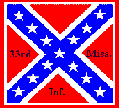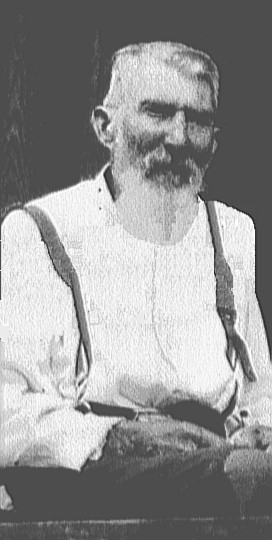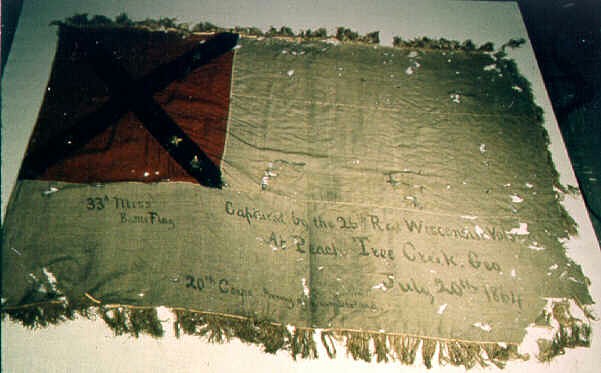


James
Jefferson Anderson and his brother, John
Anderson, volunteered with the Amite Defenders of Amite
County,
Mississippi. This
unit was organized into Company K of the 33rd Miss. Infantry
Regiment on 1 March 1862 at Grenada, Mississippi.
The regiment’s first action was at Corinth on Oct. 3-5, 1862, as a part of Villepigue’s Brigade.
The unit won mention for conspicuous gallantry for assaulting with empty
weapons and successfully driving Yankees from their entrenchments.
In
November, 1862, the brigade was ordered to Port Hudson, LA; the brigade
commander died during the march. Brigade
command passed to General Rust for a time, then to General Featherston.
In March, 1863, Featherston was ordered to the Snyder’s Bluff area to
check reconnaissance activity by Sherman’s troops
using Porter’s gunboats to traverse Steele’ s Bayou and Rolling
Fork and Deer Creeks. The 22nd and
the 33rd were involved in two skirmishes with Sherman’s forces before moving to Edwards
to join other forces being
assembled to meet Grant’s movements south of Vicksburg.
The brigade was slightly involved at
the Battle of Champion’s Hill on May 14, 1863, as a part of Loring’s
Division. Loring believed his
division to be cut off by the Federals from the rest of Pemberton’s forces so
he evacuated the division back to Jackson by way of Crystal Springs.
The unit participated in Jos. E. Johnston’s movement toward the Big
Black in an attempt to relieve Vicksburg but retired to Jackson upon
Vicksburg’s surrender.
The
33rd, still a part of Featherston’s Brigade, was involved in the defense of
Jackson (Miss.) in July, 1863, against Grant’s invasion force.
Their position was in earthworks on what was then the north side of
town near what is known in the histories as the position of the “Cotton
Bale Battery” (artillery which
used bales of ginned cotton as fortifications).
This site is just southeast of the new Baptist Hospital on State Street
at the top of the hill. The battery
commanded a field of fire from northwest to northeast toward the present sites
of Millsaps and Belhaven Colleges.
The
regiment went into camp at Canton with Loring’s Division after the fall of
Jackson, then retreated to Demopolis, Alabama, when Sherman began moving east
toward Meridian. They were moved in
the spring of 1864 to Rome, Georgia, to participate in Johnston’s
resistance to Sherman’s advance from Chattanooga toward Atlanta.
The regiment was involved in the battles at New Hope Church and Kennesaw
Mountain (Georgia) and was directly involved in repulsing Sherman’s assault at
Kennesaw Mountain. The unit was
again committed in the Battle of Peachtree Creek (just
outside old Atlanta). The unit saw
general duties in the trenches around Atlanta and evacuated with the troops when
Atlanta was surrendered.

The
next major action was in the assault of the Federal lines at Franklin,
Tennessee, on November 30, 1864. The
33rd advanced against the extreme
right (east side) of the
Federal line with elements of dismounted cavalry providing their only protection
on the right flank. The unit
crossed the entire field and directly assaulted the
Federal earthworks; a Lt. Shaw from Co. K. planted the regimental colors
on the earthworks before being shot down. John
Franklin Anderson was wounded while in double-quick
march before reaching the line and retired from the field under his own power.
While awaiting medical assistance at the rear, he received a second,
fatal wound to the head from a Yankee artillery aerial burst or an errantly high
musket shot. (The Battle of
Franklin cost the lives of 424 Mississippians, the greatest loss of any of the
Confederate states represented. The
“gallant Hood of Texas” did indeed “play Hell in Tennessee.”)
Some
remaining elements of the 33rd were present and perhaps took part in
the Battle of Nashville. Upon
Hood’s retreat into Alabama, the 33rd drew rear-guard duty to hold
off as best they could the Federal cavalry sent to “dog” them.
On December 25, 1864, at Anthony’s Hill, in the vicinity of Pulaski,
TN, James Jefferson Anderson and others of Co. K were surrounded by cavalry and
ordered to surrender. Upon doing
so, the first man who stepped from cover was shot dead by a Yankee sergeant who
apparently did not intend to take prisoners.
JJA fired his musket from cover, killing the Yankee sergeant, but drawing
fire from others and was grazed across the back.
A Yankee officer rode between the adversaries preventing any more
spurious surrender offerings and took the company into custody.
JJA held the rank of 3rd Sergeant at the time of his capture.
Soon
after their capture , those of Co. K, including JJA, that were healthy enough to
endure travel were transported to Camp Chase, Ohio, and incarcerated as
prisoners of war. They remained
there until war’s end. Upon his
release JJA traded his wedding band for enough provisions to start the trek home
to Mississippi. The duration of his
journey and the means by which he traveled are not known but, given the
conditions extant at the immediate end of the war, it can be presumed that he
walked a significant portion of the distance and would have been many weeks
completing the trip. John Anderson was one of the 424 Mississippians interred in the McGavock Cemetery at
Franklin.

Sources: Military History of Mississippi, 1803 - 1898 by Dunbar Rowland
Various records found in Mississippi Archives
Family stories
